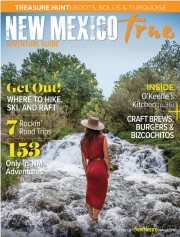Catron County – The Village of Reserve and the Mongollan Pueblo
Dona Ana County – The Cities of Las Cruces and Sunland Park, the Towns of Anthony and Mesilla, and the Village of Hatch
Grant County – The City of Bayard, the Towns of Hurley and Silver City, and the Village of Santa Clara
Hidalgo County – The City of Lordsburg and the Village of Virden and lots of ghost towns 🙂
Luna County – The City of Deming and the Village of Columbus
Sierra County – Cities of Elephant Butte and Truth or Consequences, and the Village of Williamsburg
Socorro County – The City of Socorro and the Village of Magdalena and lots of ghost towns 🙂
Catron County Points of Interest
Ake Site – A prehistoric archaeological location near the town of Datil in the San Augustine Basin, it has been dated during the Clovis period between 10999 BC 8000 BC, and during the Folsom period between 7999BC and 5999 BC, making it among the oldest inhabited sites in the American Southwest.[3]
Bat Cave – Formed by ancient wave, the cave was covered by an inland sea 35 miles long and 165 feet deep 15,000 years ago. In the late 1940s and early 50s, archeologists found stone artifacts of human inhabitation spanning 5,000 years.[7]
Bearwallow Park
Bearwallow Mountain Lookout Cabins and Shed – Built in 1940 by the Works Progress Administration, they are one of three New Deal-era buildings in the Gila National Forest.
Black Mountain Lookout Cabin
Catwalk National Recreation Trail – A remnant of a water system for the former mining town of Graham, as many as 29,000 visitors a year walk on the Catwalk’s trail or picnic at the mouth of the canyon.
The Catwalk National Scenic Trail offers a fascinating glimpse into the geologic and historic foundations of southwest New Mexico. The result of cataclysmic volcanic actions, the area now offers a beautiful picnic spot next to Whitewater Creek, a challenging one-mile trail along the historic 1890’s mining waterway, and a sense of place that creates images of an earlier time.
Cooney’s Tomb – Located on the outskirts of Alma and near the ghost town of Cooney, Cooney’s Tomb is a large boulder beside the road. It marks the burial location of James C. Cooney, a miner in the area who was killed by Apaches in 1880.
El Caso Lake
El Caso Lookout Complex – Built in 1934 by the Works Progress Administration, the complex was one of three New Deal-era forest fire lookouts built in Catron County.
Glenwood State Trout Hatchery
Mangas Mountain Lookout Complex
Mogollon Historic District – The site of many historic buildings, Mogollon was a successful mining town until the turn of the 20th century.
Mogollon Baldy Lookout Cabin
Mogollon Pueblo
Whitewater Canyon National Forest Recreation Area
Zuni Salt Lake and Sanctuary – The Pueblo people of the Southwest have made annual pilgrimages to Zuñi Salt Lake to harvest salt, for both culinary and ceremonial purposes for thousands of years. Ancient roadways radiate out from the lake to the various pueblos and ancient pueblo sites.
Dona Ana County Points of Interest
Branigan Cultural Center
Dripping Springs Natural Area
El Camino Real de Tierra Adentro National Historic Trail (part)
Las Cruces Farmers’ & Crafts Market
Las Cruces Museum of Art
Las Cruces Museum of Nature and Science
New Mexico Farm and Ranch Heritage Museum
Old Mesilla district, which dates to the early 1850s. Its stately brick-and-grass plaza, surrounded by mostly Territorial-style adobe buildings, contains art galleries, gift shops, bars, and restaurants. The 162-year-old Basilica of San Albino casts long shadows upon the north end of the plaza, while a block south and east, you can toast your arrival with margaritas, green-chile-smothered steaks, and rolled tacos at atmospheric La Posta de Mesilla, which occupies an 1840s Butterfield stagecoach station.
Prehistoric Trackways National Monument
Organ Mountains–Desert Peaks National Monument
San Andres National Wildlife Refuge
White Sands National Monument (part)
Grant County Points of Interest
Gila Cliff Dwellings National Monument – Gila Cliff Dwellings National Monument offers a glimpse of the homes and lives of the people of the Mogollon culture who lived there from the 1280’s through the early 1300’s. Containing 533 acres, it was established on November 16, 1907. The dwellings are located forty-four miles north of Silver City, New Mexico, on Highway 15.
The Gila Cliff Dwellings National Monument is surrounded by the Gila National Forest and lies at the edge of the Gila Wilderness, the nation’s first designated wilderness area. Wilderness means the intrusion of roads or other evidence of human presence will not alter the character of the area. This unique area comprising homes of prehistoric Indians in southwestern New Mexico offers a glimpse of the homes and lives of Indians who lived here from the 100’s to 1300.
Settlers in the early 1870’s penetrated the mountain wilderness, where rise the three forks of the Gila River in search of water and fertile land on which to homestead. They were surprised to find traces of an earlier race of men, who in the dim past had lived, loved and farmed the narrow valleys. Fallen walls of stone, strewn with pottery fragments, clearly indicated a people of high culture who made their homes there.
The cliff dwellings were built in the 1280’s. These Pueblo people built their homes in natural caves and in the open. There are examples of both types of settlements in the monument area. Probably not more than 8 or 10 families lived in the cliff dwellings at any one time. The rooms were probably not used more than one generation.
These small, diligent, artistic people lived in cliff houses and riverside villages, tilling mesa top and riverside fields with digging sticks, grinding cornmeal with metate and mano, fashioning pottery and cloth, carrying on trade with Indians of other communities, hunting, and gathering wild plants and fruit to supplement their squash, corn, and beans. They were skilled potters, producing handsome brown bowls with black interiors and black-on-white vessels.
The women averaged 5’1″ and the men about 5’5″ in height. They were slight of build, yet muscular, with dark hair and eyes and brown skin. The sounds of their voices and laughter echoed in the canyon. And then there were only the sounds of the streams and birds.
Seven natural caves occur high in the southeast-facing cliff on a side canyon, and five of the caves contain the ruins of cliff dwellings–about 42 rooms. Walls of the buildings were constructed of stone. All the timbers seen in the dwellings are the originals. Tree-ring dates obtained from these timbers range through the 1280’s. The cliff dwellers had abandoned their homes and fields by 1300. Why they left and where they went are not known. Perhaps they joined other Pueblo Indians to the north or south.
Gila National Forest
Hidalgo County Points of Interest
Coronado National Forest
Gila National Forest
Luna County Points of Interest
City of Rocks State Park – The incredible volcanic rock formations give this park its name. Visitors can camp, hike and explore the rocks. Enjoy the amazing night sky at State Parks’ first astronomical observatory
Formed of volcanic ash 30 million years ago and sculpted by wind and water into rows of monolithic blocks, City of Rocks State Park takes its name from these incredible rock formations. Cactus gardens and hiking trails add to this unique destination.
The rock formations at the park are so unique that they are only known to exist in six other places in the world. Imaginative visitors may see the rock formations as a small city, complete with houses, chimneys, courtyards, and streets.
Until 1200 A.D., Mimbres Indian roamed this area and left arrowheads and pottery shards as evidence of their culture. Spanish conquistadors also spent time in the area, carving crosses into the rocks.
Visitors can see a sampling of southwestern plant and animal life. The park’s desert botanical garden is home to cow’s tongue and bunny ear cacti, Yucca, and towering Century plants. Deer, antelope, javelinas, and jackrabbits are frequently seen in the area, along with over 35 species of birds, ranging from Golden Eagles to finches.
Deming Luna County Mimbres Museum
– Located in the 1916 red-brick National Guard Armory building, the Deming Luna County Mimbres Museum has about 25,000 square feet of exhibition space. The visitor will find a bit of everything here including a Military Room, the Quilt Room, the Doll Room and the Tack Room. The museum also tells of life in the Southwest, showing a Mimbres Room that showcases Mimbreno Indian Pottery.
An excellent display of memorabilia of early pioneer life. . .with relics of Fort Cummings (1863), Camp Cody (WWI) and the Deming Air Base (WWII). You’ll also linger at displays of rocks and minerals, old cars, a 1918 fire truck, early day kitchens and dental offices as highlights.
Completed two months after the famous Pancho Villa Raid (March 9, 1916) at Columbus, the Armory in which the museum is located, later served both as a community social center and as a USO activity center.
Luna County Historical Society purchased this building in 1977 for use as a museum, when the new armory was finished.
You will enjoy many fine exhibits…too numerous to picture here. Walk down the streets of pioneer Deming; admire the charming ladies’ styles of early 1900’s. Visit the Quilt – Lace room. Two thousand bells and hundreds of whiskey bottles, portraying every real and fictional character you can name, will hold your attention.
The huge chuckwagon used on the giant Diamond A Ranch is here. This ranch was one of the many vast spreads of the early years of ranching. Deming’s railroad prominence shows in having a Harvey House, duplicated in a nostalgic display.
Pancho Villa State Park
Sierra County Points of Interest
Cibola National Forest (part)
El Camino Real de Tierra Adentro National Historic Trail (part)
Gila National Forest (part)
Spaceport America
Socorro County Points of Interest
Bosque del Apache National Wildlife Refuge – Bosque del Apache is Spanish for “woods of the Apache,” and is rooted in the time when the Spanish observed Apaches routinely camped in the riverside forest. Since then the name has come to mean one of the most spectacular national wildlife refuges in North America. Here, tens of thousands of birds–including sandhill cranes, Arctic geese, and many kinds of ducks–gather each autumn and stay through the winter. Feeding snow geese erupt in explosions of wings when frightened by a stalking coyote, and at dusk, flight after flight of geese and cranes return to roost in the marshes.
In the summer Bosque del Apache lives its quiet, green life as an oasis in the arid lands that surround it.
The Refuge is 57,191 acres located along the Rio Grande near Socorro, New Mexico.The Refuge is located at the northern edge of the Chihuahuan desert, and straddles the Rio Grande, approximately 20 miles south of Socorro, New Mexico. The heart of the Refuge is about 12,900 acres of moist bottomlands–3,800 acres are active floodplain of the Rio Grande and 9,100 acres are areas where water is perted to create extensive wetlands, farmlands, and riparian forests. The rest of Bosque del Apache NWR is made up of arid foothills and mesas, which rise to the Chupadera Mountains on the west and the San Pasqual Mountains on the east. Most of these desert lands are preserved as wilderness areas.
Managed by the U.S. Fish and Wildlife Service, Bosque del Apache NWR is an important link in the more than 500 refuges in North America. The goal of refuge management is to provide habitat and protection for migratory birds and endangered species and provide the public with a high quality wildlife and educational experience.
Bosque del Apache is located on the northern edge of the Chihuahuan desert. Elevations range from about 4500 at the river level to 6,272 at the top of Chupadera peak and includes riparian and desert habitats. Consequently, the animals reflect the different habitats on the refuge. Several species of mammals including coyotes, mule deer, and elk occur on the refuge. Over 340 species of birds and many species of reptiles, amphibians and fish live here.
Plants are many and perse to reflect the different habitats of the refuge. Cottonwoods are spectacular in October/early November. Visit the Desert Arboretum and the plantings around the visitor center for a sample of plants found both on the refuge and in the North American deserts.
Refuge trails are easy hikes with benches and observation points along the way.
Hiking and nature observation can be enjoyed at the refuge’s three wilderness areas – Chupadera, Indian Well, and Little San Pascual.
Visitors are welcome to picnic at their vehicles. Please pick up and pack out all litter.
Primitive camping is available on a reservation basis to educational and volunteer groups only. Pack out all litter. All fires are prohibited.
Cibola National Forest (part)
Elephant Butte Lake State Park and Reservoir – The largest and most popular lake in New Mexico, Elephant Butte Lake State Park provides a setting for every imaginable water sport. The visitor center offers regional interpretive exhibits. The mild climate of the area makes this park a popular year-round destination.
Elephant Butte Reservoir, created by a dam constructed in 1916 across the Rio Grande, is 40 miles long with more than 200 miles of shoreline. Although constructed to provide for irrigation and flood control, the lake is New Mexico’s premier water recreation facility. A wide variety of water sports are available at the lake, with fishing being one of the most popular.
Over 100 million years ago, the area was part of a vast shallow ocean. Once the sea receded, the area was the favorite hunting ground of the tyrannosaurus rex dinosaur. Evidence of the Rex, the largest land-dwelling predator of all time, and other species of dinosaur have been discovered in area rock formations.
Although fossils of the stegomastodon (a primitive relative of today’s elephant) have been discovered just west of the reservoir, the area was not named for its former and formidable inhabitants, the name “Elephant Butte” was derived from the eroded core of an ancient volcano, now an island in the reservoir, in the shape of an elephant.
Karl G. Jansky Very Large Array/National Radio Astronomy Observatory
The Very Large Array One of the world’s premier astronomical radio observatories, consists of 27 radio antennas in a Y-shaped configuration on the Plains of San Agustin fifty miles west of Socorro, New Mexico. Each antenna is 25 meters (82 feet) in diameter. The data from the antennas is combined electronically to give the resolution of an antenna 36km (22 miles) across, with the sensitivity of a dish 130 meters (422 feet) in diameter.
The VLA is an interferometer; this means that it operates by multiplying the data from each pair of telescopes together to form interference patterns. The structure of those interference patterns, and how they change with time as the earth rotates, reflect the structure of radio sources on the sky: we can take these patterns and use a mathematical technique called the Fourier transform to make maps.
Each antenna: 25 m (82 ft) in diameter, 230 tons.
The array: there are four configurations: A array, with a maximum antenna separation of 36 km; B array — 10 km; C array — 3.6 km; and D array — 1 km. The telescopes are switched between these configurations every four months or so.
El Camino Real de Tierra Adentro National Historic Trail (part)
Salinas Pueblo Missions National Monument (part)
Sevilleta National Wildlife Refuge
Trinity Site AKA Ground Zero


